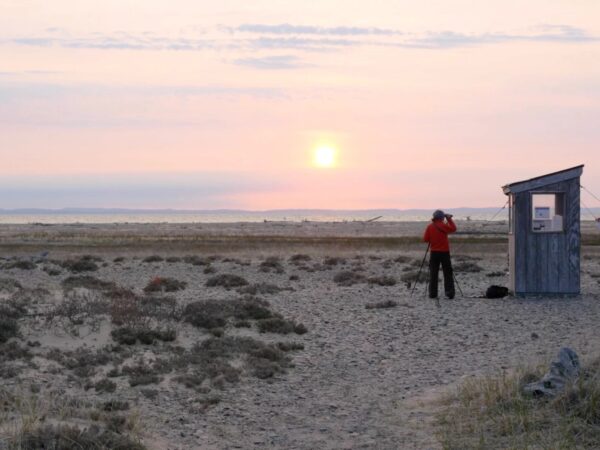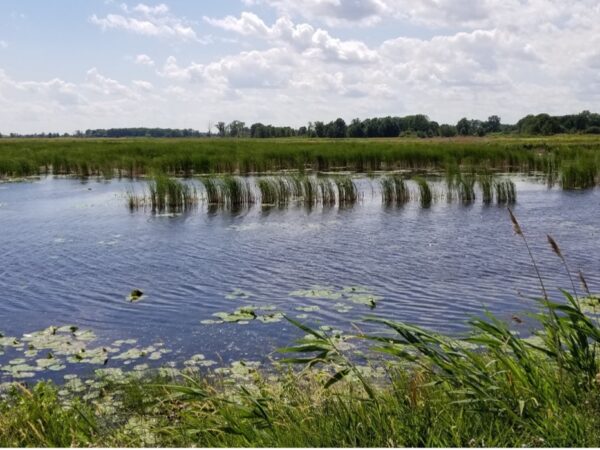
Great Lakes Moment is a monthly column written by Great Lakes Now Contributor John Hartig. Publishing the author’s views and assertions does not represent endorsement by Great Lakes Now or Detroit Public Television.
A class of chemical compounds that are no longer produced in significant quantities nor being used in the manufacture of new products, called polychlorinated naphthalenes, or PCNs, has been found in herring gull eggs in the St. Lawrence River. You may be surprised to learn the probable source of these chemical contaminants is the Detroit River.
There are some natural sources of PCNs, however, the vast majority of the compounds originate from human activities. PCNs are found in trace amounts in polychlorinated biphenyl, or PCB, mixtures, and by unintentional formation from other processes. PCNs started to be produced for high-volume uses around 1910 in both Europe and the United States.
PCNs were heavily used in wood preservatives, as additives to paints and oils, as electrical insulators, and in capacitors and transformers. Emissions also occur when they are formed as by-products from the incineration of chlorine-containing organic wastes such as municipal and medical waste, Chlor-alkali production, thermal industrial processes, and combustion of wood or coal. Worldwide annual production of PCNs was approximately 150,000 metric tons per year until production started to decline in the late 1970s, and most large-scale production stopped in North America in 1983. Current emissions tend to be dominated by unintentional formation, but there can be substantive stores of PCNs buried in sediment which can be released if disturbed.
PCNs elicit a range of potent toxicological effects in humans and animals. Exposure to PCNs reportedly can provoke liver disease, disrupt the nervous system, suppress the immune system, and interfere with the endocrine system leading to reproductive disorders and toxicity to a fetus. And they persist in the environment, food, and humans.
Herring gull monitoring program
Herring gulls are large waterbirds that eat a wide range of food including fish, invertebrates, plants, and garbage. They are the most widely distributed gull in the Northern Hemisphere and are found in all five of the Great Lakes.
Environment and Climate Change Canada has been monitoring contaminant levels in herring gull eggs for almost five decades. They are considered a key indicator of ecosystem health because they are a year-round resident on the Great Lakes, they feed primarily on fish, have relatively high fat or lipid content in their eggs where contaminants accumulate, and are considered a top predator in the Great Lakes food web.

Herring gull eggs. (Photo Credit: Shane de Solla)
Contaminant trends in herring gull eggs
Since the early to mid-1970s, the concentration of PCBs and DDE, the breakdown product of the pesticide DDT, in herring gull eggs have substantially declined in the Detroit River on Fighting Island and Western Lake Erie on Middle Island. For example, since the early to mid-1970s PCBs in gull eggs have declined by about 90% on Fighting Island and about 70% on Middle Island. In addition, DDE concentrations in herring gull eggs have declined about 90% on Fighting Island and about 85% on Middle Island.
Detroit River serves as a reservoir of PCNs
Monitoring of PCNs in herring gull eggs throughout the Great Lakes during 1979-2013 has shown that concentrations were highest in western Lake Erie, immediately downstream of the Detroit River, at 3 micrograms per kilogram. The further the distance away from the Detroit River, the lower the concentration of PCNs. For example, the concentration of PCNs in herring gull eggs in the St. Lawrence River, more than 500 miles away, was only 0.034 micrograms per kilogram.
PCNs declined in gull eggs from 1980 to 1995, but eggs from colonies immediately downstream of the Detroit River had a brief resurgence in concentrations from 1995 until 2005. The small resurgence in PCNs in herring gulls and fish corresponded with navigational dredging to maintain the proper depth in the shipping channels and some contaminated sediment remediation projects. The effects appear to manifest themselves as far downstream as Lake Ontario and the St. Lawrence River. The different forms of PCNs, called congeners, in gull eggs before dredging were noticeably different. However, after dredging they became more similar.
This research reaffirms that legacy compounds can have resurgences of concentrations in birds and fish following any dredging of contaminated sediment. Although the concentrations of PCNs in gull eggs downstream of the Detroit River were much lower than levels of PCBs, their contribution to total toxicity as measured by dioxin-like activity was approximately 22% of total toxic effect. This is substantial when compared to other toxic contaminants like PCBs or dioxins and furans.
Generally, legacy contaminants, including PCNs, have been declining in surficial or suspended sediment, surface waters, and in biota over the past few decades. Like many other persistent organic pollutants, PCNs tend to attach to sediments, and thus are slowly buried in sediments in Great Lakes, where they sit undisturbed creating a buried reservoir. Resuspension of persistent organic pollutants like PCNs from long-term sediment stores can reverse these declining trends by remitting these stores, causing a resurgence of contaminants in the environment.
“Concentrations of PCNs in sediment from the Detroit River are 10 to 1,000 times higher than those elsewhere in the lower Great Lakes, and thus represent a substantial reservoir of PCNs,” said Shane de Solla, an ecotoxicologist with Environment and Climate Change Canada. That makes the Detroit River a “hotspot” of PCN contamination.
“Any resuspension of PCN-contaminated sediment from the Detroit River could have a substantial influence on both levels and the changes in PCN profiles in wildlife and fish downstream,” he said.
Like other persistent organic pollutants, PCNs are highly hydrophobic – they do not mix with water. They tend to absorb and adsorb with sediment, including suspended solids in the water column. Suspended solids carrying PCNs can be washed downstream by river currents, and albeit more slowly, by the flow of water through the Great Lakes. Further, despite not being water soluble, trace levels of PCNs dissolved in the water column can also be transported downstream. All waters in the Detroit River end up in the St Lawrence River.
“Although the rate that these contaminants are transported downstream is slow, the cumulative effect over years can cause measurable increases in fish and wildlife downstream,” de Solla said.
John Hartig is a board member at the Detroit Riverfront Conservancy. He serves as a Visiting Scholar at the University of Windsor’s Great Lakes Institute for Environmental Research and has written numerous books and publications on the environment and the Great Lakes. Hartig also helped create the Detroit River International Wildlife Refuge, where he worked for 14 years as the refuge manager.
Catch more news at Great Lakes Now:
Great Lakes Moment: Students help save sturgeon
Great Lakes Moment: The imperiled mussels of the Detroit River
Featured image: Adult herring gull. (Photo Credit: Shane de Solla)




